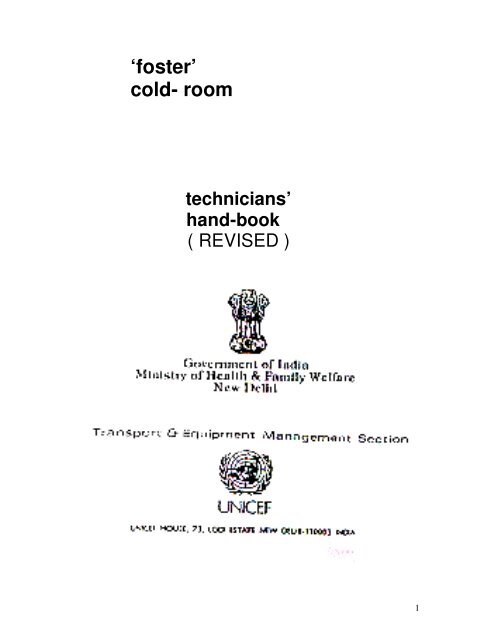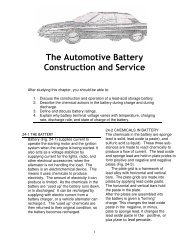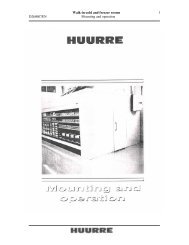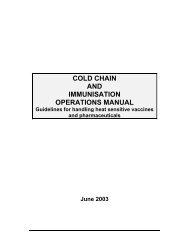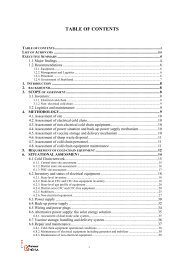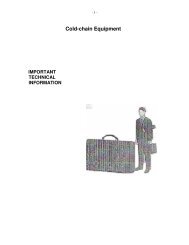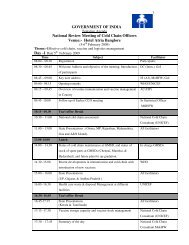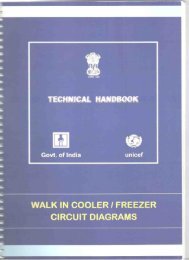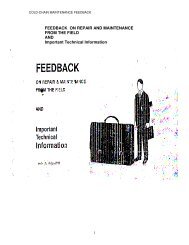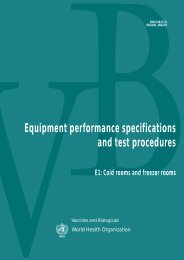Foster Cold-Room Technicians Hand Book - Nccvmtc.org
Foster Cold-Room Technicians Hand Book - Nccvmtc.org
Foster Cold-Room Technicians Hand Book - Nccvmtc.org
- No tags were found...
Create successful ePaper yourself
Turn your PDF publications into a flip-book with our unique Google optimized e-Paper software.
‘foster’cold- roomtechnicians’hand-book( REVISED )1
‘<strong>Foster</strong>’ cold- room<strong>Technicians</strong>’ <strong>Hand</strong>-bookContentsPageGeneral Information 3Interconnection wiring between different units 5Layout diagrams 6Description of main componentsGenerator panel<strong>Cold</strong>-room panel (old type) 7 & 18‘Solo’ Units 19 & 25Circuit/Layout DiagramsWalk-In-cold rooms 9 - 17Walk-In-Freezer rooms 20 - 25Normal Operation1. Initial starting & normal operations 272. Alarm condition (high temp in cold-room) 283. Mains Power Supply failure conditions 284. Alarm Condition – Generator engine failure 28Trouble-shootingA. No general power failure, but generator is running 31B. No power failure, Mains power available upto generator panel, but 32generator is runningC. In case of power failure, Generator is running but unit not working 33D. Generator does not start in case of power failure 34E. Alarm condition – Generator Engine Failure 34F. <strong>Cold</strong>-room panel/Unit 36G. Battery does not get charge 36H. <strong>Cold</strong>-room temperature observed to be different than the set range 37J. Maintenance of battery. 37Appendix :2
FOSTERWALK-IN-COLD-ROOMGENERAL INFORMATIONThe <strong>Cold</strong> <strong>Room</strong>:One of the most important links in thecold-chain is Walk-In-<strong>Cold</strong> <strong>Room</strong>. This is usedfor bulk storage of vaccines at + 4 0 to +8 0 C atstate level or regional storages.This insulted room is kept cold by two numbers ofidentical cooling units, mounted on its walls. Theworking of the cooling units are controlled by theirthermostats, which switch ON and switch OFF thecompressors depending upon the inside temperatures. Thethermostats of units are so adjusted that one unitworks when the inside temperature is about + 5 0 C and goesoff at about + 4 0 C and the other works when thetemperature is about + 7’0C and goes off at about + 6 0 C.The evaporator-fans of the cooling units (inside thecold-room) blow the cold air from the units andcirculate the air inside the cold-room. They runcontinuously so long the unit is on.The condenser-fans of the units (outside the cold-room)cool the condenser coils and they run only when thecompressors work.Power-supply:The cooling-units run from 220 voltssingle- phase, 50 Hz. AC power supply, normallyfrom the mains (network).Stand-by Generator & Generator Panel: To keep the cooling unitsrunning on the event of Network (Mains) powerfailure, a stand- by generator is provided. Incase of power failure, the generator can bestart automatically.In case of ‘Automatic’ selection, the generator panelsenses the power failure and sends signals automaticallyto start the generator. If the generator could not starton the first starting signal the control sends anothertwo more starting signals to the generator atintervals. Even then. If the generator does not startan alarm is given (The alarm can be put off by bringingthe MAN/AUT selector switch to ‘0’ position once).If the generator starts and runs, the power from the3
generator is connected after little delay, to one of thecooling units only, to continue the cooling. The unit towork from generator is to be pre-selected by selectorswitch on the cold room panel. When Mains power returnsthe generator power is cut off and the generator isstopped and also the Mains power is reconnected to theunits automatically by the generator panel. Also, duringthe running of the generator, if its lube oil pressurebecomes low or the engine temperature becomes high thegenerator is stopped automatically and an alarm isgiven (The alarm can be put off by bringing the MAN/AUTselector switch to ‘0’ positionIMPORTANT:Alarm system:The 12 volts car battery on the generator isnot only for starting the engine, but also forsupply of 12 V. DC to the generator panel. Soif the battery voltage is low or the battery isdischarged the generator will not start incase of power failure both automatically andmanually.The alarm system provided in thecold-room panel, monitors the cold-roomtemperature and actuates Audio & Visual alarmwhen the temperature rises to about + 10 0 C.After the temperature becomes normal, the alarm can beput off by pressing the Reset button, But if thetemperature still remains higher, this can be put offonly by switching off the mains supply.Temperature Recorder:The temperature recorder records thecold-room temperature continuously on acircular chart. The chart runs onecomplete round in 7 days. So the chart isto be changed each week. Also whenexhausted, its writing ink capsule is tobe changed.4
Automatic Defrostion:The moisture in the air inside thecold-room gets frozen and form frost on theevaporator coils of the units. For bettercooling efficiency they are to be meltedfrom time to time.Defrosting is done automatically by thedefrost timers in the cooling units. Thetimers put off the units for a present timetwice in 24 hours at an interval of 12 hours.This allows the frost to melt and drain out.INTERCONNECTION WIRING BETWEEN DIFFERENT UNITS5
FOSTER6
COLD ROOMDESCRIPTION OF MAIN COMPONENTS IN CONTROL PANELSGENERATOR PANEL:MAN/AUT selector switch –Voltmeter –Ammeter-to select Manual or ‘Automatic’operation of Generator At ‘0’Position the generator Start/Stop andfunctions are OFF.to indicate Generator Voltage whenthe generator is running.to indicate current drawn from thegenerator.alarmMAINS IN (Green) Indicator lamp – to indicate when Mains power ismade available to cold-room.ALARM (Red) Indicator lamp – to indicate failure of generatorFuses –S1 (5A) – Control D.CS2 (5A) – Battery charging D.CS3 (5A)S4 (5A) – AC to Battery chargerS5 (5A)S6 (5A) Control A.C from Mains.S7 (5A)S8 (5A) Control A.C from Generator.Generator Breaker. MI – Circuit Breaker for Generator# Power supply from generator comesto Terminals A & O of MI.NK – Contactor Mains Power Supply# Power supply from mains comesto Terminals 2T1 & 4T2 of NK.GK – Contact, Generator power supply# Power from Generator panel goesfrom Terminals R & O of terminalstrip to <strong>Cold</strong>-<strong>Room</strong> panel.7
COLD-ROOM PANEL: (new type)B1, Circuit breaker – to trip-off power to <strong>Cold</strong>-room panelin case of fault or overload.B2, Alarm Rest Button- ‘<strong>Cold</strong>-room high temperature Alarmcan be put OFF by pressingthis button after alarm Condition is over.B3, selector switch – to select working of Unit-I or Unit-2from generator power at ‘0’position power to both The units isOFF, (either from Mains or fromGenerator).Indicator lamp (Red) -T1 Alarm thermostat –to indicate alarm condition.works and actuate the alarm in caseof high temperature in the cold-room.C1, Alarm relay – to operate the alarm system.C2 Low voltage protector.COOLING UNITSThermometer –to indicate inside the temperature.S1, ON or OFF switch - to put the unit ON or OFF.CB1, circuit breaker –to trip –OFF power to the compressorin Case of fault or overload.CB2, circuit breaker – to trip – OFF the unit control & fansin case of Fault or overload.C1, contactor for compressor – to put the compressor ON & OFF.Thermostat –to sense the temperature insidethe cold-room & to put the compressor & considerfanON or OFF as per requirement.8
DESCRIPTION OF MAIN COMONENTSNo COMPONENT DESCRIPTION RECOMMENDEDS1 5A 5*20 mm fuse Pilot fuse 12v ADJUSTMENTS2 5A 5*20 mm fuse Charging rectifier 12vS3 5A 5*20 mm fuse Charging rectifier 220vS4 5A 5*20 mm fuse Charging rectifier 220vS5 5A 5*20 mm Pilot fuses main 220vS6 5A 5*20 mm Pilot fuses main 220vS7 5A 5*20 mm Pilot fuses main 220vM1 Mini circuit breaker AlternatorGK Contactor AlternatorNk Contactor MainsN1 Ralay Main senaing11-pin-nocketrelay220vT1 Time delay FI 12v atarting time 20 sec(30.)T2 Time delar FU 12v atop time 20sec(30.)T3 Time220v delayed alternator 10sec.(5)E1 Charging rectifier 220v/12v/5ARH1 Relay StartRH2 Relay StopR1 Relay 11-pin-socket-relay 12v DCR2 Relay 11-pin-socket-relay 12v DcMains1*220vHjalte Nattestad a-sNattestad Dk 2800 Glostaup . DenmarkEel 02-456265* T1 Startingprogramme s=8 sec.(staring time) only if5 sec. pause fittedDate 850227 Corr851125861110 SWITCHBOARD1*220V / 50Hz 3-68-137Orawn jb lsConsir 01ScaseOrder no69409
12 V .DC from BatteryA1MAN / AUT(1-2) closed onEither selectionR1= Dc sensing relay*R1 (1-3)remains closed solong correct DC voltage isavailable from any ofBattery/charging rectifier billopens when DC is availablefrom dynamo whengenerator is running.# N1 (8-11) closes on mainspower failure.M = Starting motor ofgenerator engine.T1 = Starting time (delay tooperate)R2 = Alarm relay@ T1 (9-11) closes afterpreset time on StartingFailure.10
220 V. GENERATOR PANEL (Part)‘ FOSTER ‘ WALK-IN-COLD-ROOMN1 = Mains sensingrelay.61 & 62 are auxcontact of generatorcontactor which arenormally closed.NK – mainscontactor.220 V.AC To generator 220 V. ACFROM MAINS battery forTO COLD-ROOMChargingPANELCOLD – ROOM OPERATTING FROM MAINS SUPPLYDIAGRAM :111
220 V. GENERATOR PANEL (PART)‘ FOSTER ‘ WALK-IN-COLD-ROOMTERNATOR *M1=Generator220 V Breaker, normally1 Ø kept CLOSEDT3 delay to operate,Allows generator tobuild up voltageT2 = Stop timer61 & 62 are contact ofNK contactor whichare normally closed.220 V.ACTO COLD-ROOMPANELDIAGRAM :3COLD ROOM OPERATING FROM GENERATOR SUPPLY12
12 V.DC from Battery* A1 (1-2) closed on eitherMAN / AUT selectionØ A1(11-12) closed at AUTOSelection# N1(6-7) closes and returnof mains-power@R2 (9-11) closes andstops engine in alarmconditionT2 = stopping time,delay torelease, holds itself & RH2for preset time (throughT2(1-3) to allow the engineto stop completely.GENERATOR STOPPING CIRCUITDIAGRAM :413
GENERATOR PANEL (PART)‘ FOSTER ‘ WALK –IN – COLD / FREEZER-ROOM12 V . DC from Battery* A1(1-2) closed on either MAN / AUTselectionP2 (6-7) holding contacts for R2Closws when engine lube oilpressure is lowCloses when engine temperatureis highT1(9-11) closes after preset time onengine starting faiureGENERATOR FAILURE ALARM CIRCUITDIAGRAM :514
COLD ROOM PANEL(220V 1-Ø)(New type)DIAGRAM :615
DIAGRAM :716
12 V .DC SUPPLY & BATTERY CHARGING CIRCUITGenerator – Panel(Part)# S4 fuse is not used in this circuitin generator-panels for 3-phase400 V.used with the Freezer<strong>Room</strong>s.(-ve) when DC is abailablefrom Batt/Chargingrectlfier & generator is notrunning(+ve) when Generator isrunning & DC is availablefrom Dynamo.DIAGRAM :817
DESCRIPTION OF MAIN COMPONENTSGENERATOR PANELA1 = Selector switch MAN/AUTC1 = Capacitor 220 Mfd,for starting – timer T1D1 = Diode for RH1. 1 AD2 = Diode for RH2. 1 AD3 = Diode Auto start circuit 1 AE1 = Automatic charging rectifier 12 V/5 A for batterycharging and D.C supply,GK = Contactor, generator powerJ1 = Voltmeter, generator power, 0-250 V.AC,J2 = Ammeter, generator power, 0 – 40 A. AC,M = Starter motor, 12 V.DC for engine startingM1 = Circuit breaker, generator power output cktNK = Contactor, mains powerN1 = Relay, mains sensing, 220 V, AC (remains operated so longmains power is available),R1 = Relay, D.C sensing 12 V, DC (remains operated so long12 V.DC is available),R2 = Alarm Relay Generator Failure 12 V.DCRH1 = Start relay, 12/20 A (for starter motor supply),RH2 = Stop relay 12/20 A (for stop solenoid supply),S1 = Fuse, 5 A, (DC supply for control circuit),S2 = Fuse, 8 A, (DC output from charging rectifier),S3 = Fuse, 5 AS4 = Fuse, 5 A AC input charging rectifierS5 = Fuse, 5 AS6 = Fuse, 5 A AC input to relays N1, NK & lamp X2 from mainsS7 = Fuse 5 AS8 =T1 =Fuse 5 A AC input relays T3, GK & voltmeter from generatorStarting timer, 12 V.DC (0-60 sec) Fi (Delay operateoperates only when generator fails to start withinits present time),T2 = Stop timer, 12 V.DC (0-60 sec) Fu (operates instantaneouslyand releses after its present time),T3 = Delayed alternator timer, 230 V.AC, (Delay to operateallows generator to build up voltage),X1 = ALARM/AUTO STOP indicator lamp 12, V (Generator failureX2 = MAINS IN indicator lamp 220 V.Z1 = START press button (N.O) for manual starting of Genr.Z2 = STOP press button (N.O) for manual stopping of Genr.18
COLD-ROOM PANEL (and cold-room)Indicator lamp (Red) – to indicate Alarm condition, 220VB1 = Circuit breaker, (power input to panel)B2 = Alarm Rest button (N.C)B3 = Selector switch Unit ½ operation on generator supplyB4 = Switch for room lamps (on cold-room wall)C1 = Alarm relay, 220 V, to operate the alarm systemC2 = Low voltage protectorH = Door heater, (in cold-room door)L1 = <strong>Room</strong> light, 220V (inside cold-room)Lo = <strong>Room</strong> light, 220 V, (outside cold-room)N = Switch bl location indicator neon 220 VT1 = Alarm thermostat (set operate at + 10’0CTR = Temperature Recorder Unit (on cold-room wall)(Set for 1 revolution in 7 days)SOLO COOLING UNITSC1 = Contactor 220 V for compressor motor supplyCB1 = Circuit breaker (compressor motor circuit)CB2 = Circuit breaker (control circuit &fan motors)S1 = Power ON/OFF switch of the unitT1 = Defrost Timert o = TEMP STAT Thermostat for compressor motor controlM = Compressor motor (Condensing Unit)HP/LP = Pressostat (Differential), Compressor & Condenser- fancontrol circuit)POWER NEON = Power ON indicator lamp, 220 VREFGN NEON = Compressor & condenser – fan supply ONindicator LAMP 220VEVAP.FAN = Evaporator fans (inside cold-room)COND. FAN = Condenser fans (outside cold-room).19
DESCRIPTION OF MAIN COMONENTSNo COMPONENT DESCRIPTION RECOMMENDEDS1 5A 5*20 mm fuse Pilot fuse 12v ADJUSTMENTSS2 5A 5*20 mm fuse Charging rectifier 12vS3 5A 5*20 mm fuse Charging rectifier 220vS4 5A 5*20 mm fuse Pilot fuse mains RS5 5A 5*20 mm fuse Pilot fuse mains SS6 5A 5*20 mm fuse Pilot fuse mains TS7 5A 5*20 mm fuse Pilot fuses alternator 220vS8 5A 5*20 mm fuse Pilot fuses alternator 220vM1 Mini circuit breaker AlternatorGK Contactor AlternatorNk Contactor MainsN1 Ralay Main senaing11-pin-nocketrelay220vT1 Time delay FI 12v atarting time 20 sec(30.)T2 Time delar FU 12v atop time 20sec(30.)T3 Time 220v delayed alternator 10sec.(5)E1 Charging rectifier 220v/12v/5ARH1 Relay StartRH2 Relay StopR1 Relay 11-pin-socket-relay 12v DCR2 Relay 11-pin-socket-relay 12v DcMains3*400/231V* T1 Startingprogramme s=8 sec.(staring time) only if5 sec. pause fittedHjalte Nattestad a-sNattestad Dk 2800 Glostaup . DenmarkEel 02-456265Date 850227Orawn jb lsConsir 01Corr851125861110ScaseSWITCHBOARD1*220V / 50Hz3-68-137Order no694020
FREEZER ROOM OPERATING FROM MAINS SUPPLYDIAGRAM : 1(a)22
400 V(3-Ø)GENERATOR PANEL(part)FOSTER WALK-IN-FREEZER-ROOM400 V.3 -0 ACTO<strong>Cold</strong> – roomPanel* M1 = GeneratorBreakerNormally keptCLOSED.T3 delay to operate,allows generator tobuild up voltage.FREEZER – ROOM OPERATING FROM GENERATOR SUPPLY.DIAGRAM : 3(a)23
‘FOSTER’ WALK- IN-(FREEZER ROOM)DIAGRAM : 6(a)24
‘FOSTER’ WALK- IN-(FREEZER ROOM)‘SOLO’ COOLING UNITS(400 V.3-Ø)DIAGRAM : 7(a)25
TROUBLESHOOTINGFOSTERCOLD-ROOM# The COLD-ROOM panel referredhere is of Old-type.26
FOSTER WALK COLD-ROOMOPERATION & TROUBLE –SHOOTING1) INITIAL STARTING & NORMAL OPERATIONS:# Before connecting the Battery on the generating set be sure thatthe MAN/AUT selector switch on the generator-panel is at ‘0 ‘position.# Before switching the mains power supply ON, keep the MAN/AUT selector on thegenerator-panel at ‘0’ position and On-OFF ‘switch (S1) of cooling units at OFF positions.Put the Main-switch ON (Refer-Digram 1), if mains power isPresent, main power will be available at terminals R (2T1) & 0(4T2) on relay NK of generator panel. Relay N1 (ingenerator panel) will operate which in turn will operate relay NKand ‘Mains-In’ indicator leap (X2) will glow. Relay NK operatingthe mains supply will be available at the outgoing terminals R & Ofrom where it goes to the cold-room panel.The power supply for the cold room panel is extended (from the aboveR &O terminal points either from mains (as explained above) or fromthe Alternator of the Generating Set (which we will discuss laterunder network failure condition.Depending upon the position of selector switch (b2) on cold-roompanel (for operation of unit 1 or unit 2), the power supply comingfrom Terminals R & O of Generator Panel will be extended to theselected unit (unit 1 and unit 2) and the corresponding indicatorlamp (either h1 or h2) will glow. Power supply for unit 1 isextended from outgoing terminals 1 and 2 and that for unit 2 isextended from terminals 3 and 4 of the cold room panel to theterminals L &N of the selected unit.Both the cooling units are similar ,but only one unit works at atime as per selection by selector ‘b2’ of cold room panel.On putting ‘ON’ the switch of the unit, the ‘power’ neon will glowand Evaporator-Fan will run. The Evaporator fan runs continuouslyso long the unit is ‘ON’, When the temperature inside the coldroom is higher than required and the unit is not in defrost cyclethe thermostat will operate the contactor C1. In turn thecompressor and condenser fan will start functioning and‘Refrigeration’ neon will glows accordingly. When the required low temperature isattained inside the cold room thermostat cuts offthe contactor C1 which, in turn stops the compressor. The‘condenser-fan’ also stops and ‘Ref neon goes off’. When thetemperature inside cabinet again rises and attains thepreselected / present higher limits, the thermostat will again operateand the above action will be repeated. This way the temperatureinside the cold room will be maintained within the required ranges.27
2.Alarm ConditionThere are alarm circuits (a) in the cold panel forhigh temperature inside the cold-room and (b) in the generatorpanel for low engine tube oil pressure and/or hightemperature and failure of the engine to start (Detail atitem: 4 at page 3).When temperature inside the cold room rises to or above thepresent temperature thermostat T1 operates. Its contactsclose and operate light and audio alarm (If any) and alsoalarm relay C1. The alarm continues even If alarm conditionis over.The alarm should go off when reset button b2 is pressedand temperature inside the cold-room panel has come down. It willnot go off till the temperature the temperature inside the cold room comes down below +10 0 C even though b2 is pressed.3 Mains Power Supply Failure Condition (Generator Panel)As soon as the main power fails. Relay N1 and NK drop off andlamp X2 extinguishes.a) When MAN/AUT selector is at 0 OFF position, thegenerator will not start automatically and cannot bestarted manually also.b) When MAN/AUT selector is at (MANUAL) positionThe generator-set will not start automatically but can bestarted manually by pressing START button. On pressingthe start button relay RH1 operates and the starter ofthe engine (M) works and starts the engine. Release thestart button when the engine gains speed. When thegenerator has built up required voltage relay T3 willoperate after the present time (10 sec) (Ref Diag 2,3)and will turn operate relay GK, which will extend thegenerator power supply to R&O output terminals for coldroom panel (consumption).28
When mains power supply will return relay N1 will operateagain but NK will not operate and also X2 will not glow. Nowto stop the engine press STOP button (Ref Daig 3 & 4) Onpressing STOP button relays T2 and RH2 will operate and T2will hold itself and RH2 for present time (20 sec) to permit theengine to stop completely.At the same time T2 will oake GK to release (Ref Diag. 3 & 1)GK releasing Generator supply to cold-room panel will thecut-off and NK will be operated which will extend themains-supply to cold-room panel again. If by any chance, whenthe generator was running for trail etc, power failure occurswithin that period N1 and NK will release and GK will operateand will connect generator power supply to cold room panel.But on return of mains power supply the engine is to bestopped manually by pressing STOP button as explained aboveand then only the mains-contactor NK will operate extendingmains power supply to the cold room panel.c) When MAN/AUT Selector is at 2 Automatic) position (Ref Diag1,2)In case of mains power failure, relays N1 and NK releases. Therelease of NK disconnects the mains supply circuit from outputto cold room panel and also operates relay RH1 that will makethe starter of the Engine (M) work. When engine picks upspeed, T3 will operate after a present time (10 sec) (Ref Diag3). T3 will operate GK and generator power supply will beextended to the cold room panel. When engine picks up speedR1 will release & in turn release RH1 and stop engine starter.When mains power supply returns, relay N1 will operate again,Which in turn will operate RH2 and T2(Ref. Diag.4), TheOperation of RH2 will make the ‘stop-solenoid’ work to stop theengine. T2 will operate and will hold itself and RH2 forpreset time (20 sec) to permit the engine to stop completely,also T2, while operating, will release OK which will withorawthe generator supply and operate NK to reconnect the mainssupply to the cold-room panel..4) Alarm Condition: Generator Engine FailureIf engine failure alarm lamp X1 glows and give alarm signal and the generator is observedto be not functioning or in standstill, itwill indicate any of the following:a). Starting failure – (engine failed to start)b) Too low lube oil pressure Due to which the enginec) Two high engine temperature was stopped automatically29
a) Starting Failure: Under power failure condition when MAN/AUTselector is at 2 (AUTO) position, NK releasing operates RH1 (asdetailed earlier at 3c) and also Relay T1 gets supply tooperate. But it actually operate only after the lapse ofpresent time (20 sec) If the engine tried but could not startduring above time, T1 will operate and will release RH1 andhence stops starter (M) and also blocks further start command(If generator starts within the present time of T1 of GK willoperate before the above present time. Then T1 will beprevented from operation and no alarm will come).b) Too low lube oil pressure: If lube oil pressure becomes low(normal) 2.B BAR 40 Psi in the engine while running the oilswitch (P) in the engine will operate which will in turnoperate Relay R2 and Alarm lamp X1 will glow and alsoaudio-alarm will come. R2 operating operates RH2 and T2 andengine will stop detailed earlier at 3c R2 will hold itselfand X1 till it is reset (To reset bring MAN/AUT selectorswitch to 0 position).c) Too High Engine TemperatureThe alarm will stop when the selector is turned to ‘0’position. But in case of above failures (in a & b) it will notactuate again and engine can be tried to start/started afterdue checkup and attention. But in case of high enginetemperature (for engine running for longer period poorventilation etc) engine thermostat will operate and remainclosed till the temperature reduces to required level. Henceturning selector to MAN or AUT position may actuate R2 andX1 again and stop any further starting if the temperature ofthe engine is still high than normal.30
Trouble-Shooting (Genr Panel/ MAINS-CKT)NOTE: In case of electrical troubles – always check the FUSES andcircuit breakers firstCircuit breakers trip off/ fuses blow off when there is an overloadin the circuit in which they are incorporated. In such casesreset (put on again) the circuit breaker/replace the blown – offfuse with one of same capacity and observe if the same trips off/blowsoffagain. If trip/blow-off occurs again this will meanthat there is a persistent fault in the circuit. Assistance fromMaintenance Engineer will be necessary to rectify them.A. No General Power Failure. But Generator Is Running (Local powerfailure condition)Blowing-off of fuse in main-switch or tripping-off of circuitbreaker in the mains-supply circuit or at any other stage ofthe network may also actuate the generating set. To confirmit, connect an electrical lamp across R (2T1) & 0 (4T2)terminals on NK relay. If mains-supply circuit defectivethe lamp will not glow. (Also with a multimeter or voltmeterthe mains supply at the control may be tested across the abovepoints). In such cases put the mains switch OFF & ascertainand locate the fault in the mains circuit (If required, throughlocal PWD/SEB/PHE electrical technicians) and rectify itAfter rectification, put the mains-supply switch ON again.31
B) NO POWER FAILURE; POWER AVAILABLE UPTO (2T1 60 (4T2 ON NK RELAY BUT GENERATOR IS RUNNING.Check Fuses S5 and S6 – if defective – replaceIf OKObserve Relay N1 – if not operating – replaceIf operatingObserve Relay NK – if not operating – replaceIf operatingAfter replacement, the engine should—if not— NOTIFY MAINTENANCEStop now and mains power to cold room ENGINEERPanel will be available32
C) IN CASE OF POWER FAILURE GENERATOR IS RUNNING BUT UNIT NOTWORKING1. Check if Voltage shown - If not - a) check fuses S7 & S8 & replacedefective ones..If yesb) Check generator breaker N1, IfTripped-off, reset2. Check voltage across terminals c) Check Alternator output voltageR&Oacross terminals. A-DIf not If available, the i) If no voltage, alternator mayAvailable fault is beyondbe defectiveGenerator panel NOTIFY MAINTENANCE ENGINEER(see F at page12)ii) If voltage available .3. Observe relay Ok If not operatingIf operatingObserve T3 & Aux. 61-62 of NKCheck the continuity of If operating Any of above not operating-The panel AAMETER.Replace.If defective – replace.OK should operate now.(By shorting the 2 Ok shouldterminals, of the ammeter, operate –UNITS can be kept operat-Ing till replacement)If Operating If not operating, OK may beDefective – replace.If OKOperatingIf OK notoperatingNOTIFY MAINTENANCEENGINEER4. Observe voltage across If not availableR & O again.NOTIFY MAINTENANCE ENGINEERIf availableProceed as per‘F’ in page. 1033
D) GENERATOR DOES NOT START IN CASE OF POWR FAILURECheck MAN/AUT selector position. If it is at ‘0’ or MAN (I) Position, the generator will notstart automatically. Change position to AUT (2), the generator should start automatically,If it does not start, then change selector position to MAN (1) and try to start manually.GENERATOR DOES NOT START IN EITHER ‘MAN’ OR ‘AUTO’ POSITION OFSELECTION :(While checking as below, put selector at ‘0’position),1. Check battery connections – If defective – Take out fuse S3 4Rectify Battery connection& refix the fuse.If OK2. Check fuse S1 - If loose or defective - rectify/replace itIf OK3. Check connections to terminals 1 & 2 - If defective / loose – rectify it.If ok4. Check connection battery - If poor – fit a good replacement batteryIf ok5. Return selector to ‘MAN’ & ‘AUTO’ positions one after another and observe again ifGenerator can be started, if not = NOTIFYMaintenance EnginerE) ALARM CONDITION - GENERATOR ENGINE FAILUREALARM /AUT STOP Lamp ‘x1’ will glow (& give give audio alarm) in case of any ofthe following failure: Reset alarm by turning ‘MAN/AUT’ ‘SELECTOR to ‘0’ position once.(Alarm will get cancelled in case of 1 & 2 below but will activate again in case of 31.(I)STARTING FAILURE.Engine failed to start automatically in Mains power failure condition.a) Check fuel lever in generator engine fuel tank, if empty, fill up,b) Check for any looseness at the terminalsc) Check battery for discharged /undercharged condition. Ifdischarged – replace with a charged battery ( and also follow as 6 below ¬ify MAINTENANCE ENGINEER)34
NOTE: *Turn MAN/AUT Selector to 0 before removing the battery & turninto AUT or MAN position after replacement.**Polarities are to be marked before disconnection & new Batteryshould be connected accordingly.(d) Try to start the generator again. If does not start – notifyMaintenance Engineer.(2) TOO LOW LUBE OIL PRESSURE(a) Check lube oil level in the engine chamber – If less – addrequired quantity(b) Start generator and observe lube oil pressure on the gauge. Itshould be normally 2.8 BAR (40 psi). If the pressure is observed to bearound the same, but alarm comes on again – the pressure – switch may be defective(which may have to be replaced) or generator might have stopped due to high enginetemperature.Follow as E (3) below & NOTIFY Maintenance Engineer(3) TOO HIGH ENGINE TEMPERATUREAlarm stops when selector turned to 0 but actuates again whenturned to either MAN or AUT position.a) Turn selector to ‘0’.b) Allow generator engine to cool down.c) Turn selector to AUT or MAN position and observe I alarm comesagain. If it comes allow more time to cool down further WhenAlarm does not actuate again can be started on AUTO or‘MAN’ selection.NOTE: If mains power supply return within the above OFF period ofGenerator, it will be extended automatically to the cold-room panelby operation of N1 & NK. In that case, wait till engines cools down& then turn selector to AUTO position for turn selector to AUT andallow the engine to cool down.:For any abnormality observed in the above steps notifymaintenance engineer.______________________________________________________________IMPORTANT If the MAINS POWER SUPPLY VOLTAGE BECOMES TOO LOWGENERATOR may start and run automatically, in such cases, it is advised to keep theMAINS power supply switch OFF till correct voltage is restored in the supply.35
F) COLD ROOM PANEL / UNITPower supply( either from MAINS or GENRATOR) is available at R-O, outlet terminals ofgenerator – panel , but UNIT not working.1 . Check if switch B1 is OFF – if OFF – put it ON2. Check supply voltage at terminal outlet 1-2 (for UNIT-1, selector b3at position1) & 3-4 (for Unit 2, selector b3 at position -2) If notavailable- notify . Maintenance enginer.If ON3 . Check switch ‘S1’ and Circuit – Breakers CB1, CB2 on selected unit if OFF Put ONIf ON4 . Observe the following :• Power neon should glow• Evaporator fan should runAnd• If cold room temp is higher then pre set – and also if not in defrost cycle, compressor,cond fan should run and refrigeration neon should glow – if not – NOTIFYMaintenance Enginer.NOTE : If all the above are working but yet, no cooling is obtained, observe the “sightglass”in the unit, if you can see the liquid gas. If no ges is observed or, only bubblesare observed – Refrigerant must have leaked out from the system.NOTE : Repeat steps 3 & 4 above, with the other unit also. By selecting the same withselector b3 on cold – room panel and NOTIFY OBSERVATIONS TO MaintenanceEngineer.G) . BATTERY DOES NOT SET CHARGECheck fuses , S1,S3,S4. If no changing is observed even after that, notifyMaintenance Engineer.36
H) COLD ROOM-TEMPERATURE OBSERVED TO BE DIFFERENT THAN THESET RANGENormally, the unit thermostat are adjusted in such a way that unitsstarts working when the cold room inside temperature is around 8’ 0 Cand goes of when temperature comes down to around 4 0 Cis observed that actual temperature during normal operation variesthan the pre-set range NOTIFY Maintenance Engineer.NOTE:(When large quantity of fresh vaccines is put inside the room the temperaturemay go up temporarily but will come down again after some time – this may not beconsidered as abnormality. However if temperature remains above 8’0C for morethan an hour alarm in the cold room panel will come. Reset by turning selector to 0position.I) MAINTENANCE OF BATTERYa) Open the cap on each cell and measure the specific gravity of the acid in eachcell with a hydrometer. Record the readings in a table. The gravity can very from 1.28(when full charged) to 1.12 (when completely charged) if the gravity is blow 1.23battery is to be charged separately. NEVER DISCONNECT THE BATTERYBEFORE ‘FUSE S 3 is taken out’. Refix fuse after battery is reconnected.b) The acid level in the cells should be about 5 to 10 mm above the top of theseperators. If not refill with distilled water (never addACID)c) Battery should always be kept clean and dry.d) The charging rectifier operates automatically and keeps the batteryfully charged. The battery voltage is normally 12 to 14.4 volts.e) If the battery is mounted on the generator frame ensure that it isheld firmly by the arrangement provided.f) Check the connection of terminal-clean and poles of the battery. Itshould be tight and clean. If sulphation is observed the sameshould be cleaned and refitted. The above connection point shouldalways be kept covered with some petroleum jelly.37
appendixAppendixContenta) Sequence of operation of relaysb) Loading instructions, Safety Precautions, General Maintenancec) WIC Check-chart (for Operators)d) Generator set – Maintenancee) WIC/WIF Check-list (for <strong>Technicians</strong>f) Testing Board Type 8610 and testing of different relaysg) Testing procedure for Dynamo and charging relayh) Maintenance of Charger E1I) <strong>Cold</strong>-room Panel, 1-phase 220V (Old Type)j) Freezer-room Panel, 3-Phase400 V (New Type)38
APPENDIX aFOSTER<strong>Cold</strong>-<strong>Room</strong>Sequence of operationof relaysGenerator/power-supply panel Page .1.Mains power ON 402.Mains power OF selector at AUTO starting failure 403.Generator RUNNING Selector at AUTO/MANUAL 414.Mains power Returns selector at AUTO 425.Mains power OFF Selector at MANUAL 436.Mains power RETURNS Selector at MANUAL 43<strong>Cold</strong>-room Panel 44Solo Units 4539
<strong>Foster</strong> <strong>Cold</strong> – <strong>Room</strong>Generator / power – supply panelMAINS POWER ‘ON ‘LEGEND :+ = Operator / Close- = release / open(-) = not operate(+) = held operatedN1 + _(8-11) - prevents auto start(6-7) + prepares auto stop ckt(1-3) +X2 + NK + _ (61-62) - prevents operation of gk(51-52) - prevents +ve supply from charging relay(main contacts) +Extend ‘MAINS’ supply to<strong>Cold</strong> –room panel (at R.O)MAINS POWER ‘ OFF ‘ Select at ‘ AUTO ‘ – R1 + - (1-3) + prepares start – cktNK + N1- _ (1-3) – prevents Nkoperation(8-11) +(mainContact) RH1 T1 (start)Disconnect ‘MAINS’Supply ckt. from (87-30) + (after pre-set time,20 sec)<strong>Cold</strong>-room panelM + (starts) T1 + _ (1-4)- if generator could notStart during above preset time(9-11) + This contact prevents further startcommand releases RH1 hence mALARM +X1 +R2 + _ (1-4) - prevents RH1 operation(9-11) + prepares RH2 path(6-7) +Holds R2, X1 and ALARM continues unitRESET BY BRINGING SELECTOR TO ‘O’ POSITION* STARTING FAILURE40
FOSTER COLD – ROOMGenerator / power – supply panelGENERATOR ‘ RUNNING ‘R1 -T3 (starts)When engine(after pre-set time 10sesPicks up speedallowing generator to buildup voltage)& DC is available fromDynamo T3 +(1-3) +(1-3) - GK + _(61-62) - prevents NK operation(13-14) + prepares auto- stop ckt(5-6) + prepares ‘low lubeoil alarm’ ckt.+(main (51-52) -Contacts)T1 (-) IF GENERATOR RUNS WITHINExtend ‘GENERATOR’THE PRE-SET TIME DELAY OFSupply to cold-room In case OPERATION OF T1(20 sec).Panel (at R.O) R1 doesnot release i.9 GK OPERATES BEFORETHE LAPSE OF ABOVE PRE-SETTIME (20 SEC),T1 WILL NOTOPERATE & HENCE ALARM CKT.WILL REMAIN IN-OPERATIVEFOR THE ABOVE PERIOD.RH 1 -(87-30) -M – (stops)*The above sequence of operation is common for both ‘ AUTO ‘ and ‘ MANUAL ‘position Of selector – switch.41
FOSTER COLD – ROOMGenerator / power – supply panelMAINS POWER ‘ RETURNS ‘ (ON again) selector at ‘ AUTO ‘N 1 + _ (8-11) - prevents auto –start(1-3) + prepares NK ckt .(standby).(6-7)+RH2 + T2 + (and hols for preset time, 20sec.Allowing the generator to stop(87-30) + completely)STOP SOLENOID +(1-4) - prevent RH1 operation forpreset time,20 sec.(8-11) -(1-3)GK - _ (main contacts)- withdraw(+) generator supply from cold-roomRH2, T2 holds operatedpanelfor pre-set time(51-52)+ prepares RH1ckt(standby)(after lapse of(13-14)- prevents auto–stop cktPre-set time of T2)(5-6)- prevents low lube oilalarm ckt.T2 - (61-62) +(1-3) - NK + _ (61-62) - prevents operationOf GKRH2 -(51-52) - prevents ‘+ve’ supplyFrom charging-relay.(87-30) - (main contacts)+STOP SOLENOID –Extend ‘ MAINS ‘ supply to<strong>Cold</strong> – room panel again42
FOSTER COLD – ROOMGenerator / power – supply panelMAINS POWER ‘ OFF ‘ , selector at ‘ MANUAL ‘R1+ (1-3) + preparesStart ckt.NK -N1 - _ (1-3) - prevents NK operation(main contacts)-‘ START ‘ Button PressedDisconnect ‘ MAINS ‘Supply from (contacts) +<strong>Cold</strong> – room panelRH1 +(87-30) +M + (starts)After Generator pick up speed,‘ START ‘ button Released(contacts)RH1 –GENERATOR ‘ RUNNING ‘(see page) (87-30) -M - (stop)MAINS POWER ‘ RETURNS ‘ (ON again) , selector at ‘MANUAL ‘N 1 + _ (NK - and X2 – as GK + )‘ STOP ‘ Button Pressed(contacts) +RH 2 + T2 +(87-30)+STOP SOLENOID +* Next sequence of operationSimilar to that detailed in page C ,for selector at ‘ AUTO ‘43
FOSTERCOLD ROOM PANEL (New type)1 phase , 220VSequence of operationB1 +C2 + when voltage is Door + Temp + Powerabove set limit Heater Recorder supply(supply at for lights9,10) (at.7-8)B3 (at 1)B3 (at2)Power supply for Power supply forUnit-1 (at1-2) unit-2 (at 3-4)When running on when running onGenerator supply generator supplyAnd also forand also forUNIT-2 (at,3-4) UNIT-1 (at,1-2)Through NK(33-34) + through NK (33-34) +When running on when running onNetwork supply network supply<strong>Cold</strong> – room TEMP. HIGH , above pre – set limitT 1 +C1 + C1 will hold till reset by pressingB2 after Alarm condition is overALARM +(supply at 5-6)44
FOSTER COLD – ROOM“ SOLO “ UNITSNormal running :CB1 + , CB2 + (to be kept on)S1 +Power + Evpr + T1 (working , normal)#Neon Fan(6-7) +(If system refrigerant pressuresWithin pre-set limits, HP/ LP + )(If coldroom temp higher thanPre –set lower limitTHERMOSTAT + )THERMOSTAT +C1 + Condr + Refrign +FanNeon(1-2) +COMPRESSOR +* When pre –set low temp attainedthe cold - rommTHERMOSTAT +C1 + Condr + Refrign +FanNeon(1-2 )+COMPRESSOR +DEFROSTING : 2 cycles of 20 min. duration each per day at 12 hours intervals (pre – set)T1 (Working, during defrosting)(6-7)-C1 + CONDr + REFRIGN +FANNEON(1-2) +COMPRESSOR -# After defrosting period T1 (6-7) + again & normalRunning continues as above45


